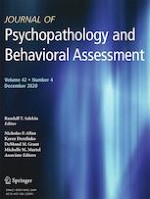24-05-2020
Measurement Invariance of Two Measures of Alexithymia in Students Who Do and Who Do Not Engage in Non-suicidal Self-Injury and Risky Drinking
Gepubliceerd in: Journal of Psychopathology and Behavioral Assessment | Uitgave 4/2020
Log in om toegang te krijgenAbstract
Non-Suicidal Self-Injury (NSSI) and risky drinking have a shared emotion regulatory function. Alexithymia is an important risk factor for both behaviors. However, it is conceivable that the emotional processing difficulties thought to underlie both behaviors may contribute to differences between people who self-injure or drink in a risky fashion, and those who do not, when interpreting alexithymia items on self-report questionnaires. Therefore, measurement invariance should be established before attributing scale score differences between groups to true differences in alexithymia. We examined the validity, factor structure, and measurement invariance of the Toronto Alexithymia Scale (TAS-20) and the Perth Alexithymia Questionnaire (PAQ) among 640 university students (Mage = 20.39, SD = 1.86) with and without histories of NSSI and risky drinking. The original factor structure of the TAS-20 was not supported; however, the addition of a reverse-scored item method factor improved fit. The intended five-factor model of the PAQ was supported. We found configural, full metric, and full scalar invariance for the PAQ and a revised-TAS-20. Both the PAQ and TAS-20 demonstrated good concurrent, convergent, and discriminate validity. Our results suggest that all subscales of the PAQ and the difficulties identifying feelings and difficulties describing feelings subscales of the TAS-20 can be used confidently to discern differences in alexithymia in the context of NSSI and risky drinking. However, the externally orientated thinking subscale of the TAS-20 had poor internal consistency and several inadequate factor loadings. We discuss the utility of the externally orientated thinking subscale (TAS-20).
